What am I?

Answer on Monday!
I just got back from a 9 hour overseas flight, just in time to post the answer to last week’s quiz. So now you know…I wasn’t in the states. More on that later.
As many of you guessed, this is a fig tree (Ficus spp.) of some sort. I have horrendous taxonomic abilities anyway, but will cover my ignorance with the excuses that the tree wasn’t in flower, nor were there any signs in any of the little parks identifying the tree. So we can continue to speculate on what species this is. I do know it’s quite an old specimen, and that there are some Ficus native to the region, but past that I’m clueless as to whether this really is a native species or not.
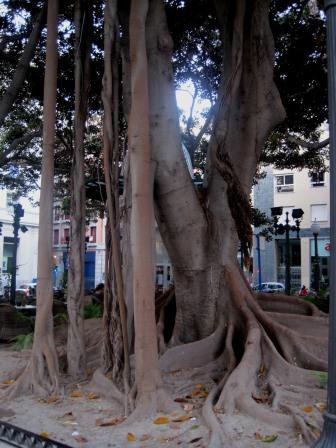
And where was this huge tree? In Alicante, Spain, where I spent a few days visiting my daughter who’s studying there this semester. (Non-scientific aside: I would go back there in a heartbeat. If you are looking for a Mediterranean tourist destination that isn’t overrun with Americans, this is the place to go.)
Finally, these cool wavy woody structures are buttress roots, as Jospeh, Shawn, Rotem and Deb all pointed out. They have both a structural and storage function: like all woody roots they store carbohydrates, but the over-developed flare helps support the tree in thin soils (like here) or in wet, low-oxygen soils (like those where mangroves grow). In both cases roots can’t reach far enough below ground to stabilize the trunk, so the buttressing serves that function.
@Rotem also noted that branches can root and support the tree. While the buttress roots in the original photo arose from root tissue, you can see examples of the rooted branches in the photo above.
And I do love the less-than-serious answers some of you kindly provided for our amusement. Fred’s "rumble strips for drunks" was particularly apropos, since my last night there was one big street party after Barcelona beat Manchester United in the Champions League soccer match. My daughter and I ended up in our hotel elevator at 8 am the next morning with a fan with no pants. We did not ask.
I’m out of town this week, and taking lots of plant pictures. Here’s an interesting tree, quite common in the city where I’m staying:
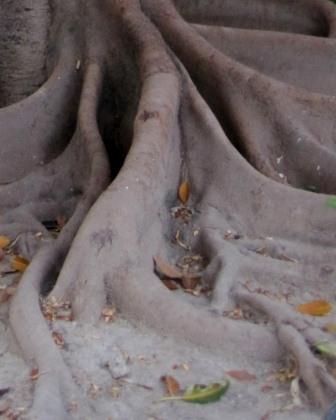
Question 1: What kind of tree is this? (Genus is good enough – species might be hard to tell.)
Question 2: In what geographical region might I be staying? (The tree is native as far as I know.)
Question 3: What are these woody structures called, and what function do they play?
Answers next week!
Paul, Joseph, Kandi and Derek are all, apparently, Puya fanciers. But! It’s not P. alpestris, but P. berteroana – a species whose flowers are more turquoise than sapphire:
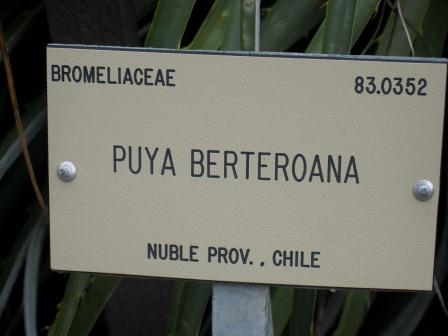
Yeah, Kandi, check out those spines! Even taking pictures is deadly!
And Paul and Joseph were correct – the long green structures are sterile (they bear no flowers) and serve as bird perches. The nectar almost runs out of these flowers, and as the birds get a sugar fix their heads are covered in pollen.
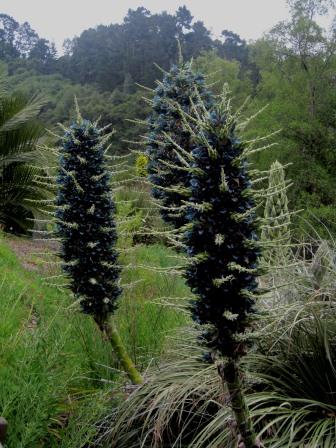
Thanks to Paul Licht, Berkeley Botanical Garden Director, for my short but fabulous tour that included these beauties.
The university’s server was down for scheduled maintenance over the weekend and I missed getting this posted. So you have until next Friday to consider this interesting flower from the Berkeley Botanical Gardens:
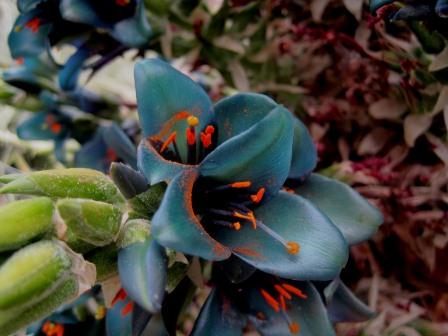
What is this plant?

And what is the function of these long, green horizontal structures?
Have fun
Ed and Gayle correctly pointed out that short day plants (those that bloom in the spring or the fall) can sometimes do both. The asters probably experienced some transplant shock in the fall, which would have suspended floral bud development. This phenomenon could also be due to mild winter conditions (as Ed and Gayle also mentioned), which could have spared flower buds normally killed by freezing temperatures.
In any case, as spring daylengths approached those found in the fall, flower development continued and voila! Asters in the spring! Likewise, there are a number of spring bloomers that sometimes have a second (usually reduced) floral display in the fall.
Thanks again to Ginny for sharing her photographs and information!
Gardeners love asters as part of their autumn floral palette. Yet these native asters are blooming now – in the spring!
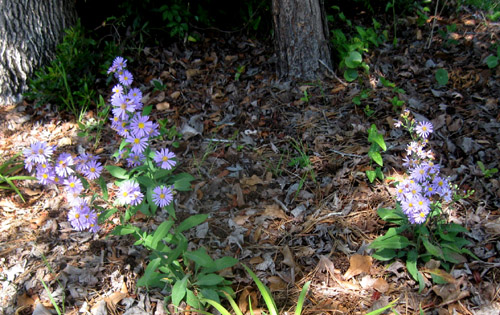
These specimens were purchased last summer and planted in the fall in Florida. Why might they be blooming out of season?
Reader Ginny Stibolt contributed today’s puzzle. If you’d like to be a guest inquisitor on our blog, send photos and explanatory text to Linda Chalker-Scott.
I really liked the answers you brave few came up with for Friday’s photo. I could absolutely see how each one made sense – but unfortunately none of them were correct. It’s actually a raindrop sitting on top of an expanding larch bud:
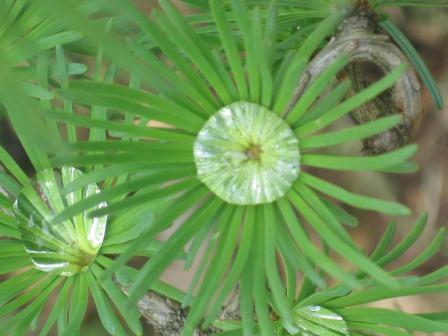
This turned out to be much trickier than I anticipated. I promise the next one won’t be.
(And no, the raindrops do not magnify sunlight and cause the expanding needles to burn!)
The odd oak in Friday’s photos is shin oak, or Quercus sinuata var. breviloba:
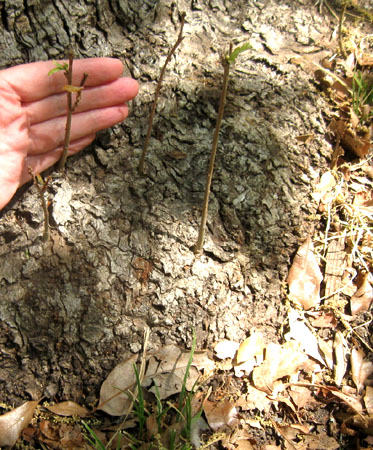
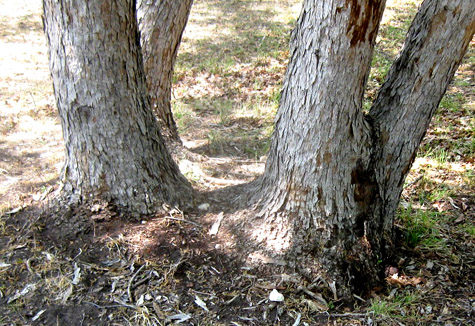
This trunk “puddle” is a really cool adaptation called a lignotuber (good job Matilija!) or burl. These are common in woody plants found in wildfire zones. New sprouts can arise after fires have roared through, or perhaps after heavy browsing by deer, as the park ranger suggested to Ginny, our guest inquisitor.
Thanks, Ginny, for sharing the photos and question. If you have an interesting plant quiz topic, preferrably with pictures, feel free to pass it on for our Friday Question!